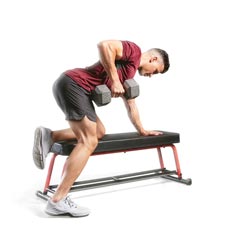While this question can be answered with a simple yes or no, it’s critical to determine a few things before jumping into a daily workout routine. The first thing we have to look at is the meaning of the term workout. What does working out actually mean? You might be thinking, does working out mean going to the gym and doing cardio and lift weights every day? Or, maybe you’re thinking about going for a run every day. Secondly, is working out every day needed for you to reach your goals? Or, based off your current circumstances, would it be wise to set up an everyday workout routine? Next, you need to think about whether or not the workouts you are going to be doing can actually be completed on a daily basis without causing overtraining. Injury, fatigue, burnout, and regression in physical performance can all happen if the wrong workouts are being performed every day. Finally, what are the ways you can reduce your risk of succumbing to the harmful effects working out every day? So, before you make your decision to work out every day, I advise you to read through the answers to the following questions below. If you’re looking for a straight up answer, yes, you should be working out every day, but doing it right will determine whether you repeat the benefits of a well-made daily workout program, or potentially set yourself up for failure and injury.
1. What is working out?
Exercise, physical activity, training, or working out can all be used to describe someone who has planned to participate in an activity that involves physically using the muscles of the body to achieve a specific goal. These goals can range from increasing heart health to training to becoming the worlds strongest human. The first step in determining if you should be working out, is to figure out if they type of workouts you want to achieve can be done every day and if they are need to help you achieve your goal.
2. Should you be working out every day?
The answer to this question depends on a number of factors. The most critical questions are whether you actually need to work out to achieve the goal you set and can your physical body handle the frequency and intensity of the program you are trying to accomplish. For example, if you goal is maintain an active lifestyle and avoid the potential negative effects of a sedentary life, then simply going on a 20-minute walk everyday would be a realistic program for most people to accomplish. If you have aspirations to win an Olympic goal medal in the decathlon, then you may need to spend time training different skills everyday while also working on your strength, endurance, and flexibility. Regardless of the goal you have and recommended frequency of training, you also need to be realistic in how much time you can commit to working out. I would advise asking yourself a few honest questions before setting up a goal to work out every day. First, have you been successful at planning and executing a workout program that involved daily physical activity? And second, where you able to complete the program and achieve your goals? If you can answer yes to these two questions, then the next step is finding out what types of physical activity are appropriate to participate in each day. If you haven’t been successful at completing daily workouts and achieving your goals, I would advise starting an exercise program with a frequency that is realistic for you to achieve. Good exercise programs can help you achieve your goals without the need for daily strenuous exercise. It’s not about the number of days you work out, it’s about making the number of days you work out count.
3. What workouts should I avoid every day?
If you are ready to take the leap and start a daily exercise routine, there is one important factor you must learn to control. That is workout intensity. The reason you need to be aware of how workout intensity can affect you, is that if you work out to hard and to frequently, you can experience something called “overtraining”. I will describe more about how to reduce the risk of overtraining shortly. When you over train, a few things can happen. Your risk for injury increases, your performance decreases, your motivation decreases, your ability to recover from your previous workout slows down, and you may even start to regress in your progress. This can happened when you perform too many days of high intensity workouts in a row for an extended period of time. High intensity exercise might include running several miles every day, lifting heavy weights for the same muscle group every day, or performing maximum effort cardio every day. Overtraining can be common with these types of training programs, because there is not enough time for the body to recover from the previous workout.
4. What workouts can I do every day?
As I previously stated, walking can be a great daily activity for most people. Along with walking, other low impact activities like, active stretching, riding a bike, and swimming can be great daily activities as long as they are performed for a reasonable amount of time. The reason these activities can be performed daily are because of their low impact effect. Low impact activities don’t put a large amount of stress on the body’s joints and muscles. Because of this, it is easier for your body to recover from the activity so you can perform it again the next day without a low risk of overtraining. Check out the chart below for activities you should avoid every day and activities you can perform every day.
5. How can I reduce the risk of overtraining?
Overtraining can have serious complications. This doesn’t just include injury to your body, overtraining can be deadly. This is why it’s important to talk to a medical professional prior to starting any daily workout program. A simple way to help reduce your risk of overtraining is to monitor your recovery time. If you feel sore or tired after a workout, rest until your soreness is resolved. If you have an intense workout, this could take a day or more. That doesn’t mean you avoid all physical activities while your resting, it means avoiding high intensity exercise until your body is ready to perform it again. The amount of time it takes you to recover can vary depending on your age and experience with exercise. The good news is that you are consistent with your high intensity training program, you can decrease your recovery time with proper rest and nutrition. Listen to your body, and learn to recognize when your body still needs time to recover. Here are a few examples of workouts most people can and can’t do every day.
Workouts to avoid everyday |
Workouts you can do everyday |
Weight lifting the same muscle groups |
Walking |
Long distance running |
Low to Moderate intensity Cardio |
HIIT workouts |
Swimming |
High intensity Cardio workouts |
Bike Riding |
|
Stretching |
6. Take home point
Working out every day is a great way to ensure that you set yourself up to achieve your goals, as long as you aren’t overdoing it. Pay close attention to how your body response to the workouts you complete. If you are still sore of feel tired after a day or two, it’s better to use caution and take an extra day off or participate in a low intensity activity.
Other blog articles you may enjoy:



























2 comments
My husband and I (both in our 70s) are trying to stay in shape and lose some weight, so we use the equipment we just purchased from you (a bike and a rowing machine) for 30 minutes, then do a 2 – 3 mile walk. I had back surgery a few years ago, so the rowing machine has really helped me strengthen my core—which is great! We both feel great but in no way exhausted or even tired, so we must not be over-training. We LOVE our new equipment!
Love the article, I really like the emails you send with all the suggestions for better workouts.